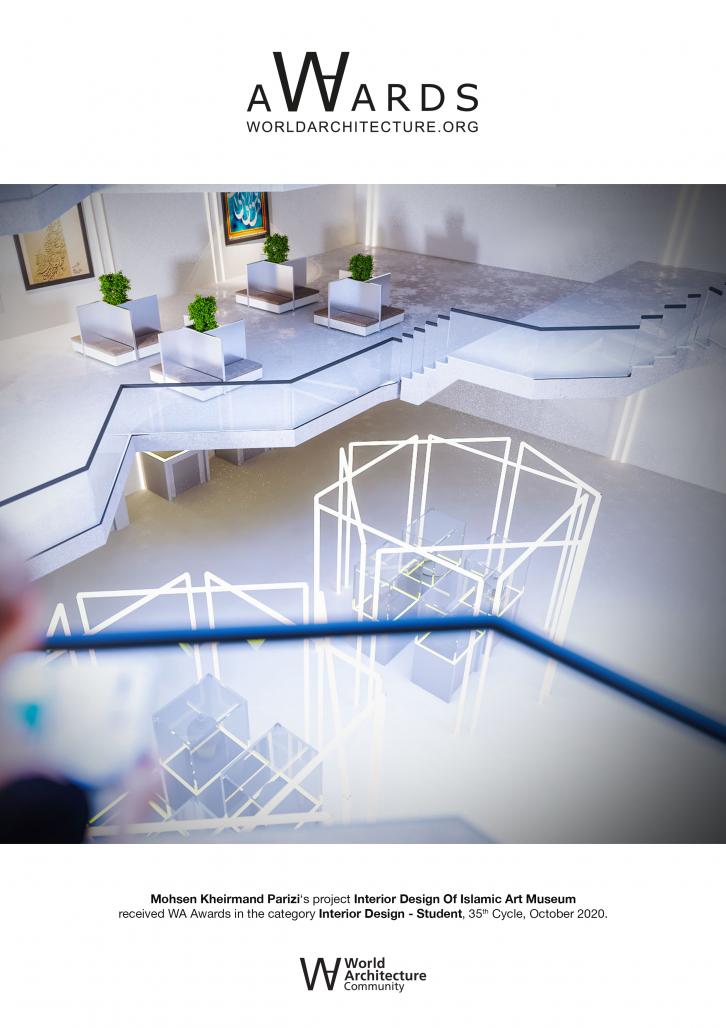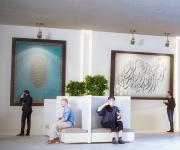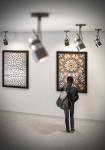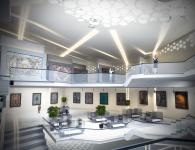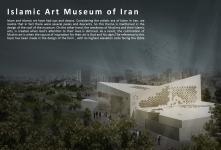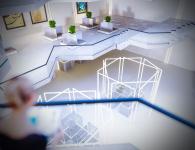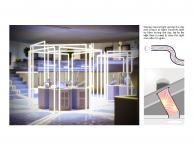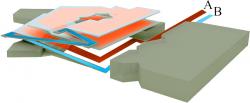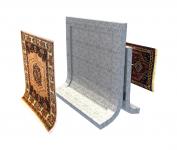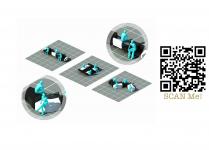Light, color, water, are the three aesthetic elements of Islamic architecture. Light is the most important characteristic of Iranian architecture and a symbol of divine wisdom. The color comes from the light revolution and the water is the image of nature in Islamic architecture. Here the project attempts to show these elements side by side. The introduction of natural light in addition to its place in Islamic art helps reduce energy consumption. Light passing through the water collected from the rain and humid air causes light effects by splitting light and displaying different colors. In addition, the collected water is used to irrigate the greenery of the Museum of Islamic Art.
Islam and Islamic art have had ups and downs. Considering the artistic era of Islam in Iran, we realize that in fact there were several peaks and descents. So this theme is mentioned in the design of the roof of the museum. On the other hand, the weakness of Muslims and their Islamic arts, is created when God's attention to their lives is dimmed. As a result, the culmination of Muslim art is when the source of inspiration for their art is God and his signs.The reference to this topic has been made in the design of the form , with its highest elevation code facing the Qibla.
Islamic knot and light rain:
The art of knitting has a very wide scope. The masters of this art in different Islamic countries have each mixed it with their own ethnic taste and they have made many knots in Islamic buildings. Nodding In general, putting node tools in a nice and harmonious composition. For this reason, knitting art, besides architecture, is found in most of the traditional Iranian handicrafts such as masonry, woodcarving, inlay, metalworking, metal engraving, pottery, carpet weaving, engraving, binding, etc. This art has been used on the walls and ceiling of the museum to bring natural light into the space, creating light rain, as well as decorating parts of the museum.
The challenge of entering natural light and Introspection:
Introspection is another Islamic-Iranian architectural principle, and this collection also has this feature. So, if anyone enters the museum, all his attention to the museum and the artwork, and there is no element that concentrates the attention of the individual outside the collection. This is a big challenge in designing and using natural light.
Because the size of the windows and openings should be such that they do not distract the attention of the users inside the museum, to the outdoor area.
At the same time, it can use the maximum potential of natural light and its entry into the collection.
The use of light-transmitting concrete made at Qom University, optical channels and chandeliers designed by end-light and side-light fiber optic lighting fibers have been the design responses to this challenge.
Transparency of light and vision:
One of the most important principles of Islamic-Iranian architecture is the principle of transparency, which has been considered in this plan. In such a way that there is no unknown space inside this museum and users can easily access it physically and intuitively. As if we stay in the central courtyard, we have visually access to the entire space.
Inspiration from the Islamic-Iranian gardens:
Inspiration from the pattern and elements of the Islamic-Iranian gardens, the combination of water and greenery in the design of the museum's premises, the use of medicinal plants, ornamental and healing, as one of the science and art of Islam, the creation of air space along with improving the health of users
The Place of Light in Islamic Art:
Art in the Muslim world has always had an unbreakable connection with light. In other words, light is one of the finest, most subtle and most amazing, semantic meanings in Islamic art And this reflection is shown on a variety of arts, such as architecture, painting and crafts. Pointing out this issue in the design, the light rain caused by the passing of light from the Islamic knot at the ceiling and walls and entering the interior space of the museum has been done.
Light as a Decorative Medium in Islamic Art and Architecture
The performance of Islamic decorative arts is enhanced by ingeniously manipulating light, which is normally admitted in abundance into Islamic buildings through diverse media. As this is same in this project too.
Allah is at the heart of worship and aspirations for Muslims, and is the focus of their lives. So, Islamic art focuses on the spiritual representation of objects and beings, and not their physical qualities. The Muslim artist does not attempt to replicate nature as it is, but tries to convey what it represents.
It is the light of God that manifests itself in Islamic architecture, especially in the mosque that is his home. " Allah is the Light of the heavens and the earth " and its role in alleviating the roughness and hardness of the stone and the building. The manifestation of the metaphysics of light on the physics of the building has made it the main axis of Islamic architectural aesthetics in mysticism and meaning. The buildings used shiny flooring, glitter and wall surfaces to capture light, and sometimes the light reflected off the diamond-shaped ceilings that causes the reflection.
Light gave the decoration of Islamic architecture a dynamic quality and drew the motifs, shapes and designs into time. The light and shade on the surfaces created intense contrasts and gave texture to the imprinted stone and plaster and brick surfaces. Light passed through wooden masonry, plaster and marble walls, and window glass and drew patterns on the interior and back surfaces, creating a timely and varied coating of color and shade.
The Place of Color in Islamic Art:
The color comes from the reproduction of light. It represents a plurality that is inherently related to unity. From the point of view of Islamic art scholars, white symbolizes the absolute existence and the black color that covers the house of the Kaaba is the main symbol of the transcendent and exalted being to which the Kaaba is associated. The blue, turquoise and gold colors in Islamic and Iranian painting are manifestations of the esoteric meanings that flow within the colors. The psychology of color in the Qur'an has also been seriously considered.
The place of water in Islamic art:
Water is the essence of existence in Islamic philosophy." وجعلنامن الماء کل شی حی ". And at the same time it is also the cause of purification. This intrinsic trait (which purifies and cleanses the filthy objects) is so closely related to the truth of Islamic architecture that its presence in the context of Islamic architecture makes it a symbol of purification.
The presence of water in Islamic architecture, especially in the mosque, not only renders it a physical object for the abbey's purification, which requires this purification for its worship, but it also purifies the attribute. The intimate connection of water and Islamic architecture in the verses of the Qur'an is felt with elegance. The water between him and the Being is at the same time the essence of the universe to His Holiness. Islamic architecture has an explosive approach to water. The unprecedented presence of water reduces the roughness of the building. Its transparency reveals the immortality of the buildings that have rested on the Hereafter.
Designed carpet stands:
Carpet as one of the Islamic arts has always been remarkable. In order to better display this art, we have designed special stands that reduce the distance of users to the work. Also, this work is beautifully displayed.
Angle-shifting and angle-changing lighting rails:
Due to changing works at different times, lighting needs to be removable. There is also a need to change the angle to better display of the work in museums, We have paid special attention to this design.
Attention to all segments of society:
All segments of society, with all restrictions, have the right to use public spaces. In this project, our team has attempted to design a space for all these loved ones to meet the needs of different classes of people such as the blind, the disabled, the deaf, or even the elderly and children with some movement limitations.
Use braille, full QR code for scientific and historical description of the work, audio files in various languages, use 3D augmented reality file for better and palpable display, attention to location of works and ... were among the steps to achieve this goal while designing the Museum of Islamic Art of Iran.
Reduces user space with artwork forbetter understanding of the artwork:
The design seeks to maximize understanding, and users' use of the work, by reducing user distances, as well as the use of multimedia to make the most of the work.
Virtual tour for 24 hours of use and acquaintance with Islamic art from all over the world:
Sometimes there is no physical presence for those interested in reading, viewing and using museum artwork. The Museum's Virtual Tour uses online cameras to view artistic augmented reality files, along with the virtual reality of the museum environment, to study, use and access artifacts from around the world and around the clock.
This in addition increases public oversight and enhances museum security.
Preserving and promoting Islamic art:
Islamic art has been taught from generation to generation. This chain must not be destroyed and these arts should not be forgotten. Workshops and educational spaces are designed to introduce and learn Islamic art in the museum's educational section that work to preserve and promote these arts.
2020
0000
Pay attention to design challenges against viruses and issues related to pandemics and epidemics:
As seen in previous descriptions and previous designs, the issue of user health has always been a concern for our team. With the outbreak of Coronavirus disease and its spread, new principles will be created in spatial design.
In this design, we have tried to use cases to prevent the spread of the disease chain along with the activities and presence of students. These include the new layout of furniture, attention to social distancing, design of handles and openings, tips and innovations related to toilets, disinfection systems for users and spaces. In fact, in this project, we have tried to be one of the first groups to design Corona and Postcorona.
Save daylight by color and materials with luminescent properties:
The entry and transmission of light is done by optical fibers, light-transmitting concrete and light channels in this design. The use of materials and paints with luminescence and photovoltaic properties saves natural light and reflects it at night, which is also very effective in the security of the museum.
Security and protection of works :
Security and protection of artworks in the museum is one of the museum's design priorities Many thefts have been caused by power outages and the gap between connecting or disconnecting the power system. The use of stored natural light during the day is uninterrupted at night, which provides permanent illumination of the space inside the museum and increases its security.
Designed carpet stands, Litracon, Optical Fiber, Light Channel, Virtual tour, Virtual Reality, Augmented Reality, Braille, QR Code of Description, Audio Files of Description in Various Languages, Using a light-transmitting concrete sample designed at Qom University
Mohsen Kheirmand Parizi, Mohammadreza Moghadasi, Seyed Mohammadhossein Rahmati, Saeed Mihan Parast, Fatemeh Ranjbarzadeh Asl, Shirin Jahed, Hanieh Lotfipour, Maryam Piraste, Seyedeh Dena Hosseini
Special thanks for advices & supports from: Dr. Mohsen Moosavi
Interior Design Of Islamic Art Museum by Mohsen Kheirmand Parizi in Iran won the WA Award Cycle 35. Please find below the WA Award poster for this project.
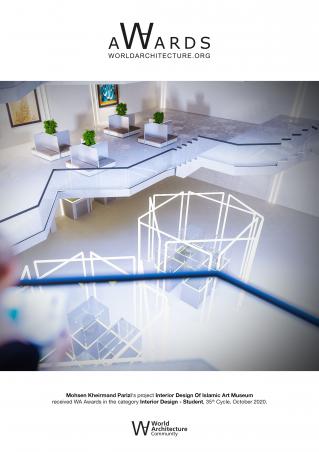
Downloaded 31 times.
Favorited 10 times

